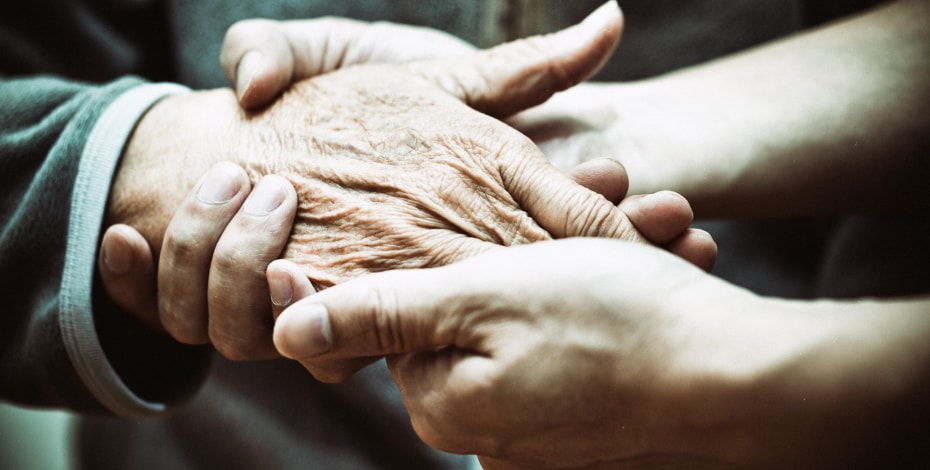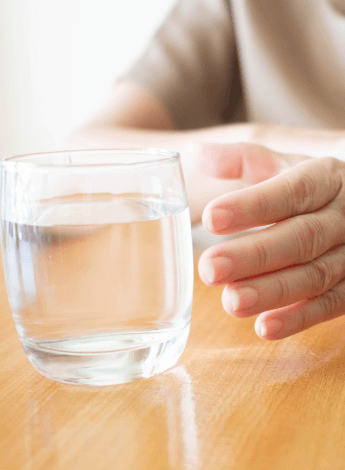
Five facts about… upper limb rehabilitation after stroke.

Sarah Amesz, Dr Simone Dorsch, Natalie Fini, Phoebe Sansom, Zhao Lin Teoh contribute five treatment modalities that are recommended in the 2017 Clinical Guidelines for Stroke Management, as well as some practical tips on how to implement them in your practice.
1. Constraint-induced movement therapy should be provided to improve use of the affected arm and hand
Constraint induced movement therapy (CIMT) refers to constraint of the intact arm and hand to increase use of the affected arm in stroke survivors. The constraint is usually applied by placing a mitt on the intact hand or placing a sling on the intact arm. CIMT programs combine this constraint with up to six hours a day of practice with the affected arm. As it involves constraint of the intact arm, it requires clear communication with the stroke survivor about the amount and type of constraint, as well as the commitment to daily practice.
The Stroke Guidelines have a strong recommendation for intensive CIMT to improve arm and hand function for those with some active wrist and finger extension in their affected arm. They recommend a daily minimum of two hours of active therapy coupled with restraint for a minimum of six hours for at least two weeks (Stroke Foundation).
A systematic review of the effect of CIMT concluded that it improves arm and hand function and increases the use of the arm (Corbetta et al 2015). A systematic review of the effect of repetitive practice on strength after stroke concluded that CIMT can increase strength in the affected arm by more than 100 per cent (DeSousa et al 2018).
2. Strength training should be provided for upper limb weakness
The Stroke Guidelines strongly recommend strength training for upper limb weakness. This recommendation is based on multiple systematic reviews that have found that strength training leads to moderate gains in strength (Stroke Foundation, Harris & Eng 2010, Ada et al 2006).
When strengthening very weak muscles, consider using different positions such as sitting, standing, supine, prone and side lying to get the optimal position relative to gravity. Equipment can be helpful to facilitate or assist the desired movement, to add resistance, prevent compensatory movements and/or enhance functional relevance. Modalities such as CIMT (Corbetta et al 2015), repetitive task practice (Corbetta et al 2015), electrical stimulation (Nascimento et al 2014), the SmartArm and the Saeboflex (DeSousa et al 2018) are effective at improving strength in very weak muscles.
If your client can move their arm against gravity but still has strength deficits, progressive resistance training is an option. However, it is imperative to also assess and address elements such as speed of movement and the ability to co-ordinate movements of multiple segments.
Importantly, take photos or videos of your client performing the exercises and provide clear instructions so they can replicate it at home or the gym as part of their independent practice program. Strengthening for very weak muscles is ideally performed with high repetitions daily and progressive resistance training ideally two to three times per week.

3. Sensory-specific training may be provided for sensory loss in the affected arm
According to the 2017 National Stroke Audit conducted by the Stroke Foundation, 36 per cent of stroke survivors present with sensory impairment. This often includes impairment in light touch and pain sensation, proprioception, vibration, kinesthesia and stereognosis. An inability to detect sensory information can negatively impact performance of tasks and this in turn can affect rehabilitation outcomes after stroke (Doyle et al 2010).
Currently sensory retraining practices are informed by a number of studies with small sample sizes. These trials have shown benefits of sensory retraining in improving sensation and activities after stroke. Sensory retraining can take the form of compression, mirror therapy, sensory integrative treatment, somatosensory retraining programs or stimulation methods (Doyle et al 2010, Carey et al 2016). Following the study conducted by Carey et al (2011), the Stroke Guidelines suggest that graded and progressive sensory discrimination training for textures and object recognition should be provided as part of a goal directed rehabilitation program (Stroke Foundation).
Stroke survivors report that sensory impairments significantly impact them and they value rehabilitation targeted at improving their sensation (Doyle et al 2010). Despite only small benefits shown in sensory retraining interventions, the Stroke Guidelines (Stroke Foundation) suggest patients are likely to want to receive intervention to address sensory loss.

4. Electrical stimulation may help improve strength and activity in stroke survivors
Electrical stimulation can be used during the practice of tasks, for example, stimulation of the wrist extensors during a reaching task and this functional electrical stimulation (FES) has been shown to give small to moderate improvements in strength and activity in stroke survivors (Stroke Foundation, Nascimento et al 2014). While it is unclear if electrical stimulation is more or less effective for people with various levels of motor recovery, it appears that it has more effect for those who are weak as well as those who are very weak, and for subacute and chronic stroke survivors (Nascimento et al 2014).
Electrical stimulation can be used passively to treat shoulder subluxation in the first six months post stroke; however, it shows no benefit in later stages (eg, longer than six months). It also demonstrates no benefit to pain management (Stroke Foundation). For both passive and active practical application of electrical stimulation, the Stroke Guidelines suggests ensuring adequate dosage. Studies suggested administration of at least five days per week for longer than four weeks for shoulder subluxation management (Vafadar et al 2015). For improving upper limb function, it is recommended to apply FES during functional retraining to maximise treatment dosage (Stroke Foundation).
5. Mirror therapy may be provided for arm weakness, complex regional pain syndrome and/or neglect
Mirror therapy is a form of motor imagery. A mirror is placed so that active movement of the non-paretic limb is reflected to create the illusion that the paretic limb is moving. Motor imagery and the observation of movement share similar cortical representation and this illusion may activate cortico-motor areas and modulate cortical excitability as well as prevent learned non- use (Thieme et al 2018).
The Stroke Guidelines have a weak recommendation to use mirror therapy as an adjunct to routine therapy to improve upper limb function for those with weakness, neglect and/or complex regional pain syndrome (CRPS). A weak recommendation means that ‘Benefits outweigh harms for the majority, but not for everyone. The majority of patients would likely want this option.’ Some patients however, may find it difficult to sustain their attention on the task.
A Cochrane review demonstrated moderate quality evidence that mirror therapy significantly improves motor impairment and function, may improve activities of daily living, and improves pain in patients with CRPS after stroke. Mirror therapy is effective in the acute and chronic phase and can be used at home without a therapist after training (Thieme et al 2018). On average, research studies investigated mirror therapy for 30 minutes per day, five days a week, for four weeks (Thieme et al 2018).
For all references email inmotion@australian.physio.
Sarah Amesz, APAM, is the deputy chair of the APA national Neurology group. Sarah works at Bunbury Hospital as the acute allied health manager and has a master’s in neurological rehabilitation from University of Plymouth.
Dr Simone Dorsch, APAM, has worked in traumatic brain injury and stroke rehabilitation for over 20 years. Simone is a lecturer in neurological physiotherapy at the Australian Catholic University and also a presenter with the StrokeEd collaboration, a group of educators who present workshops on evidence- based stroke rehabilitation.
APA Neurological Physiotherapist Natalie Fini is the chair of the APA national Neurology group. She works at the University of Melbourne as a lecturer in neurological physiotherapy and is completing her PhD in physical activity after stroke at La Trobe University.
Phoebe Sansom, APAM, is a senior physiotherapist on acute neurosciences unit at Monash Medical Centre, Monash Health. In 2017, Phoebe completed postgraduate studies in rehabilitation. She has a strong passion for improving early rehabilitation and outcomes for stroke survivors.
APA Neurological Physiotherapist Zhao Lin Teoh is the deputy chair and national representative of the WA branch of the APA Neurological group. She works at Rocky Bay as senior physiotherapist and has completed a master’s in clinical rehabilitation (neurological physiotherapy) at Flinders University in 2018.
References
1. (Australian) Clinical Guidelines for Stroke Management 2017 - Chapter 5 of 8: Rehabilitation https://app.magicapp.org/app#/guideline/2282/section/27234
2. Corbetta D, Sirtori V, Castellini G, Moja L, Gatti R Constraint-induced movement therapy for upper extremities in people with stroke. Cochrane Database of Systematic Reviews 2015
3. DeSousa D, Harvey L, Dorsch S, Glinsky J (2018). Interventions involving repetitive practice improve strength after stroke: a systematic review Journal of Physiotherapy 64:210-221.
4. Harris JE, Eng JJ : Strength training improves upper-limb function in individuals with stroke: a meta-analysis.. Stroke; a journal of cerebral circulation 2010;41(1):136-40
5. Ada L, Dorsch S, Canning CG : Strengthening interventions increase strength and improve activity after stroke: a systematic review.. The Australian journal of physiotherapy 2006;52(4):241-8
6. Nascimento LR, Michaelsen SM, Ada L et al : Cyclical electrical stimulation increases strength and improves activity after stroke: a systematic review.. Journal of physiotherapy 2014;60(1):22-30-
7. Stroke Foundation. (2017). National Stroke Audit Acute Services Report 2017. Melbourne, Australia.
8. Doyle, S., Bennett, S., Fasoli, S. & McKenna, K. (2010). Interventions for sensory impairment in the upper limb after stroke. Cochrane Database of Systematic Reviews; 6: CD006331.
9. Carey, L., Lamp, G. & Turville, M. (2016). The state-of-the-science on somatosensory function and its impact on daily life in adults, older adults and following stroke: a scoping review. OTJR; 36(2 suppl.)
10. Carey L, Macdonell R, Matyas TA : SENSe: Study of the Effectiveness of Neurorehabilitation on Sensation: a randomized controlled trial. Neurorehabilitation and neural repair 2011;25(4):304-13
11. Thieme H, Morkisch N, Mehrholz J, Pohl M, Behrens J, Borgetto B, Dohle C. Mirror therapy for improving motor function after stroke. Cochrane Database of Systematic Reviews 2018, Issue 7. Art. No.: CD008449. DOI: 10.1002/14651858.CD008449.pub3.
12. Vafadar AK, Côté JN, Archambault PS : Effectiveness of functional electrical stimulation in improving clinical outcomes in the upper arm following stroke: a systematic review and meta-analysis.. BioMed research international 2015;2015 729768
© Copyright 2025 by Australian Physiotherapy Association. All rights reserved.





